Like junior high and high school kids today, ‘80s kids stayed busy doing homework, doing research, and writing papers. When books on the subject at hand, whether it happened to be pollywogs, cavemen, or the digestive tract, weren’t cutting the mustard, we had to look elsewhere for information.
We had to look it up. This was of course way before the Internet—way before Google or Wikipedia. We couldn’t just look up information on sedimentary rocks, cross-pollination, Grover Cleveland, or the state glad of Texas on an all-powerful device in our pockets. We, instead, had to consult a big ‘ole hardback book. We looked up our facts in an encyclopedia.
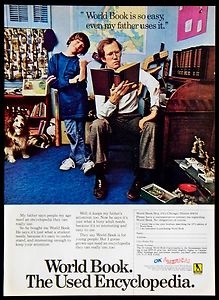 Remember those? Encyclopedias came in giant volumes arranged alphabetically containing facts on a variety of topics, from famous historical figures, plant and animal life, the human body, and historic events; these things all lived together from A-Z, typically in a 32-volume set. They made accessing important information easy. This ad is hilarious. So easy to use, even Dad can manage it.
Remember those? Encyclopedias came in giant volumes arranged alphabetically containing facts on a variety of topics, from famous historical figures, plant and animal life, the human body, and historic events; these things all lived together from A-Z, typically in a 32-volume set. They made accessing important information easy. This ad is hilarious. So easy to use, even Dad can manage it.
The volumes could be found at the library, or, if your parents fell for the door-to-door sales pitch and had the means, you had your own set of Encyclopedia Britannica on the bookshelves of your home. Or perhaps you were more of a World Book or Funk and Wagnalls (which were sold at the grocery store!) kinda kid.
Encyclopedia Were Expensive
A complete set of these giant hardbacks were so expensive that they would stay in families a LONG time, perhaps longer than their useful life. For example, if you had a 1956 set of World Books that had been passed down, the world’s countries weren’t necessarily the same by the time you were trying to do your geography report in 1983. History had changed political boundaries and country names. You had to be careful to get your facts right!
The outrageous costs of these ____-filled volumes was justified as “a great investment in your children’s future . . . [with] a wealth of important information that will pay high dividends for years to come.” So sayeth the Funk and Wagnall’s advertisement, anyway.
Hours of Thumbing Through Random Facts
I loved looking through these giant fact-factories. We would sit in the library and leaf through the alphabet, turning the pages of these fancy books learning about …well…pretty much everything. My favorites were the topics that had the extra treatment by the printers, not just black and white text. The flags of the world section was in full color – so cool. And, the coolest section of all: the human body with the see-through layers of various systems of the body that you could layer on one at the time. That level of tactile engagement with our facts is sorely missing in the Wikipedia app fact-checking of today.
They Didn’t Leave the Library!
When writing your paper on woodchucks, you’d claim a giant round table at the library and sprawl out with your loose-leaf notebook paper, your books, your number 2 pencil and your other giant book — the dictionary (this was also pre-spell check, can you imagine?!) along with the encyclopedia volume that included the letter “W.” Only then was it time to get to work. This had to happen at the library, mind you, because you couldn’t check out the W volume. What if somebody else needed to use it? It was a reference book that lived at the library.
Encyclopedias Go Digital
The 90s provided a bridge between the hardbound encyclopedias of the 80s and the online versions we have today- an intermediate step on our way to a digital existence. That bridge was in the form of the CD-based Encarta encyclopedia.
Today, with the Internet giving us information instantly on anything and everything with the click of a mouse (or more likely, a search on your phone), I was pleasantly surprised to see people still enjoy their reference books.
Still Available for the Diehard
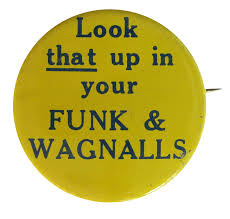 On Amazon a used copy of a 32-book set published in 2003 sells for around $320. So some family wants to unload all of this hardbound information, while I’m sure plenty of old school enthusiasts are excited to look up new entries (on say Botox and the West Nile Virus) the old fashioned way.
On Amazon a used copy of a 32-book set published in 2003 sells for around $320. So some family wants to unload all of this hardbound information, while I’m sure plenty of old school enthusiasts are excited to look up new entries (on say Botox and the West Nile Virus) the old fashioned way.
Those lovers of all things vintage look up their facts using the old school repository of all information – the encyclopedia.
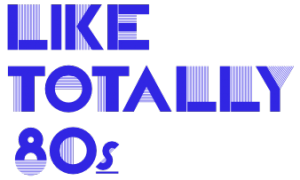
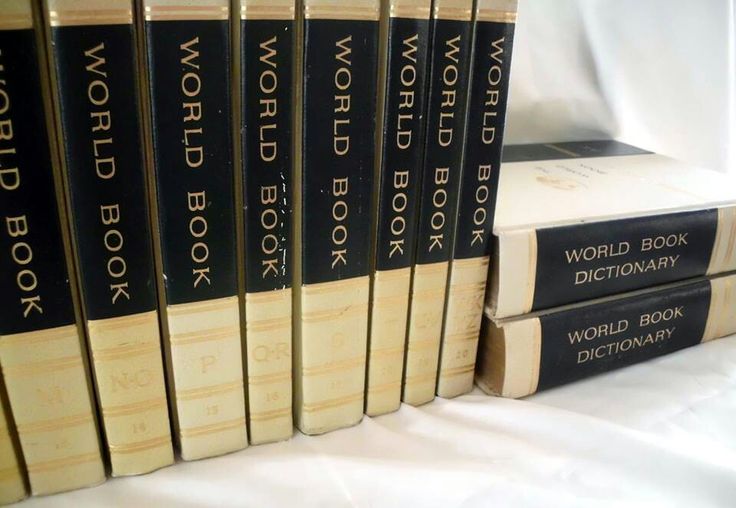
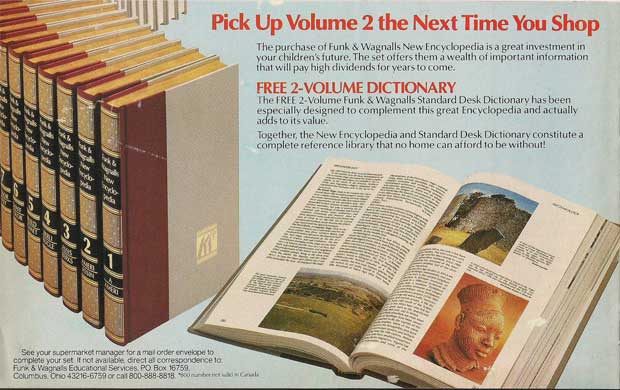
March 26, 2015
In 5th grade i had to do a report on our State’s Captial. Of course our World Book was a vital source for that report. However, I had a very difficult time finding a picture of the captial building at the local library. Sooo….. I discretely cut the picture out of the World Book. Showing my finished report to my Dad he say “Nice. Where did you get the picture?”….. not such a good idea, but back then there was no internet, nor photo copiers.
March 26, 2015
Ha! I call that effective problem solving
April 17, 2015
I remember eating cereal before school, and on table I had to have a world book…. every morning I would switch up a letter, usually in alphabetical order. Ahhhh…those were the good ol days, then after i’d eat i’d go watch inspector gadget until I had to leave.